Address any questions or comments regarding this newsletter to the individual authors listed after each article or to its editors, Nathan Johanning, 618-939-3434, njohann@illinois.edu or Bronwyn Aly 618-695-6060, baly@illinois.edu. The Illinois Fruit and Vegetable News is available on the web at: http://ipm.illinois.edu/ifvn/. To receive or be removed from email notification of new postings of this newsletter, contact Nathan Johanning or Bronwyn Aly at the phone numbers or email addresses above.
In This Issue:
Upcoming Programs (listings for beginning and established growers)
News and Announcements (2018 Cottage Food Regulations and Food Safety Compliance Dates WEBINAR, Reporting Pesticide Drift Complaints, Updates to the Midwest Vegetable Production Guide)
Regional Reports (west central 2X, east central, St. Louis metro east, southern Illinois, Dixon Springs)
Fruit and Vegetable Production and Pest Management (Rednecked Cane Borer and other Cane and Crown Borers in Brambles, Eastern Flower Thrips in Strawberries, Potato Leafhopper in Apples, Potato Leafhopper in Green Beans and Potatoes, Organic Control of Striped Cucumber Beetles, Modified Growing Degree Days, Pruning Determinate Tomatoes)
Upcoming Programs
Check the Illinois SARE calendar for a full list of programs and links for registration.
http://illinoissare.org/ and http://illinoissare.org/calendar.php
Also see the University of Illinois Extension Local Food Systems and Small Farms Team's website at:
http://web.extension.illinois.edu/smallfarm/ and the calendar of events at http://web.extension.illinois.edu/units/calendar.cfm?UnitID=629.
- Direct Food Marketing Workshops. Illinois Farm Bureau along with several Illinois County Farm Bureaus are delighted to partner with FamilyFarmed to provide 3 different 1-day workshops around the state pertaining to Direct Food Marketing in May. The offerings are May 7th (at SIU), May 10th (at Henry County Farm Bureau), and May 11th (at Champaign County Farm Bureau). Refreshments and Networking start at 8:30 with the workshop beginning at 9:00AM. All attendees will receive lunch, training, and a free workshop manual that typically retails for $70. This event is open to anyone. Participants will need to pre-register at www.ilfb.org/livelocal. For more information contact Raghela Scavuzzo (309)557-2155 or rscavuzzo@ilfb.org
- Southern Illinois Summer Twilight Series: Dixon Springs Ag Center, Monday, May 21, 2018 6 p.m. 354 State Highway 145 N; Simpson, IL 62946. This first twilight meeting of the summer series will be an open house for the "re-opening" of the horticulture research at the Dixon Springs Ag Center. We will tour the high tunnels and the current research in each, including hydroponic tomatoes, cucumbers, lettuce and in-ground production of a wide range of vegetable crops. Save the date and registration information will be up soon! For further information contact Bronwyn Aly at baly@illinois.edu or 618-382-2662.
- Southwestern Illinois Tree Fruit Twilight Meeting. Wednesday, May 22 from 5:30 to 7:30 p.m. at Broom Orchard 12803 Broom Rd, Carlinville. IL. Registration can be found at https://web.extension.illinois.edu/registration/?RegistrationID=18580 or by calling 217-532-3941. For more information people can contact Ken Johnson at 217-243-7424 or kjohnso@illinois.edu or Andrew Holsinger 217-532-3941 or aholsing@illinois.edu
- 2018 Illinois Summer Horticulture Field Day, Thursday, June 7, 2018. Annual Illinois State Horticulture Society annual summer field day will be hosted by Flamm's Orchard in Alto Pass, IL. Advance registration is $27 and includes lunch. For more information and registration visit https://www.tickettailor.com/events/ishs/136569/ or contact the society at ilsthortsoc@gmail.com or 217-621-7371
- 2018 Pumpkin Field Day, Thursday, September 6, 2018, 10 a.m. Ewing Demonstration Center (located about 20 minutes south of Mt. Vernon, IL) 16132 N. Ewing Rd. Ewing, IL 62836. Pumpkin Variety & Pest Management trials, No-till Production and more! Save the date; more details to come! For additional information contact Nathan Johanning at 618-687-1727 or njohann@illinois.edu.
News and Announcements
2018 Cottage Food Regulations and Food Safety Compliance Dates WEBINAR
May 18, 2018, Noon to 1:00pm CST
There are ongoing changes taking place in 2018 concerning the laws and regulations that impact farmers markets and vendors. Join this webinar on May 18 to learn about the new 2018 expanded cottage food opportunities and the statewide farmers market sanitation rules. Information will also be presented on the Food Safety Modernization Act Produce Rule and compliance dates for specialty growers.
Speakers will be: Rebecca Osland - Illinois Stewardship Alliance, Government Relations
Laurie George - University of Illinois Extension Educator
To register for this webinar, please click here.
Pre-registration is required to obtain access to the necessary workshop links. All workshops are free. Presentations are delivered in partnership with Illinois Stewardship Alliance, Illinois Farmers Market Association, and University of Illinois Extension
Reporting Pesticide Drift Complaints
The Illinois Department of Agriculture (IDoA) is the lead agency in the state for pesticide drift. If you suspect pesticide misuse and the situation results in your need to file a complaint, visit the IDoA "Pesticide: Use and Misuse" website at http://www.agr.state.il.us/Environment/Pesticide/pestuses.html. From there, you can download a complaint form that must be completed and submitted to IDoA within 30 days from the time you notice injury. If you don't have web access, you can still call 1-800-641-3934 (voice and TDD) or 217-785-2427 to request a complaint form. Once IDoA receives the complaint form from you, an inspector will be assigned your case number.
Updates to the 2018 Midwest Vegetable Production Guide
For those using a paper copy of the 2018 Midwest Vegetable Production Guide, some updates have been made regarding changes that have occurred since its printing in December. Visit the this article to see the details of any of those changes https://vegcropshotline.org/article/updates-to-the-midwest-vegetable-production-guide/
These updates have been made on the PDF version of the spray guide which is available at https://ag.purdue.edu/btny/midwest-vegetable-guide/Documents/2018/01_MWVegGuide_2018.pdf
Regional Reports
From west central Illinois... One last cold snap. That's at least what I keep saying. Perhaps now it is finally going to be the truth. This past Saturday flats of summer annuals went back into the high tunnel with a forecasted low of 32 degrees Fahrenheit. The actual low reached 29 degrees in Macomb, but the summer plants were well protected in the high tunnel under row cover. Unfortunately, the peach tree was not so lucky. Many blooms (Perhaps all?) were hit hard by the freezing temperatures as the flower buds began breaking open. I hope that it was just our tree that was unlucky. I have not spoken with other peach tree growers in the area to see the extent of the damage. The nectarine right next to the peach tree has about a dozen flowers in full bloom on the entire tree.
If growers experience cold damage to fruit trees, the first course of action is to evaluate the state of the flower buds whether they are alive or dead. Dissect a few flower buds and examine if you see green, living tissue, or brown dead tissue. Based on that a grower can determine if they will continue with their routine cultural practices, or shift their priorities on the farm if the entire crop is lost. A good video on evaluating peach blossoms after a freeze from Alabama Extension.
I must correct my previous regional update where I wrote our growing degree days was at 106. Turns out that was far from the actual number at that time (April 15) which was around 24 GDD in Monmouth. Currently, Monmouth reports 58 GDD (April 30). In 2017, we were at 225 GDD at this time of the growing season. (Data Source: Midwestern Regional Climate Center)
It is quite dry, which makes fieldwork a bit easier. However, in the coming days, I welcome the rainfall as planted beds could use a drink. Irrigation lines will be going in this next week as we prepare field beds for tomatoes, peppers, squash, cucumbers, and beans.
Asparagus has finally begun to emerge from our community garden in Galesburg and harvest will undoubtedly be starting soon. Most growers finally feel that busy treadmill of work speed up with warmer temperatures and many markets about to open for this growing season.
Chris Enroth (309-837-3939; cenroth@illinois.edu)
Also from west central Illinois... The weather this month has really been strange. We've only had .85" of rain this month, and all that came during the first half of the month. With the winds and low humidities soils have really dried out, in fact most corn/soybean farmers are not working ground more than one day ahead of the planter to avoid losing too much moisture. When ground is being worked or planted it's difficult to see the tractor with all the dust. We had lows of 37 degrees over the weekend, but no frost.
Sweet corn planted April 10 has two leaves emerged. It was planted just prior to several days of 80 degree highs. Sweet corn planted April 22nd is just starting to emerge.
The first blooms on Chandler plasticulture strawberries were noticed this week. The Flavorfest berries are just a bit behind as are the bare root berries, both have buds visible just emerged from the crown. We will begin our fungicide spray program within the week, when full bloom occurs.
Botrytis rot (or grey mold) appear on fruit as a grey fuzzy growth close to harvest. However it infects during bloom, that's why it's important to begin a fungicide spray program during bloom on fruits, and continuing until harvest. Rainfall is necessary for botrytis to infect and help spread the organism, therefore tightening up the spray schedule becomes necessary during wet weather. Warm and wet versus cool and dry are what this organism prefers. For more details on Botryis rot management in strawberries consult the 2018 Midwest Fruit Pest Management Guide
Asparagus harvest began the end of last week. We would expect yields to really jump with the warm temperatures in the 80's predicted this week.
High tunnel ventilation is important during spring when temperatures may be in the 50's outside, but can exceed 100 in a high tunnel, even if partially open for ventilation. At temperatures that high, it can become difficult for young plants' immature root systems to keep up with the demand of evapotranspiration. The result can be a loss of leaf or, in severe cases, the entire plant. It's always preferable to err on the side of safety if leaving the tunnel for a day and unable to regulate the temperatures regularly.
Dry soil conditions allowed for ample opportunities for field work and planting/transplanting early season vegetables and fruits. In fact, utilizing drip irrigation has begun for some to relieve dry soil conditions to allow for germination. Cole crops, greens, potatoes and onions have been placed. Some have transplanted tomatoes and peppers outside as well. Most tunnels have been transplanted to warm season crops such as tomatoes and peppers.
Early peaches are at full bloom, early apples are just showing a little pink.
Mike Roegge, Retired Extension Educator & Mill Creek Farms (roeggem@illinois.edu)
From east central Illinois... Finally it is warming up, we had light frosts in the area on Saturday morning, April 28. Warm temperatures are beginning to bring up the asparagus. Fall planted garlic is looking good. The early planted cool season crops are starting to grow in earnest. Only problems has been the cool to cold temperatures that have slowed early vegetable and fruit growth; and transplanting activities. Speaking of fruit, the fruit trees have begun to blossom in the area, this week. Currently, farmers are busy getting transplants out into the fields.
Doug Gucker (217-877-6042; dgucker@illinois.edu)
From the St. Louis Metro-east... Everywhere you look is tractors, with field operation in full swing. Soil temperatures at 4" bare ground have finally warmed into the low 60's for a minimum and well into the 70's for a max. Though the landscape is decidedly greener, some trees like black walnut and ash have yet to leaf out. Day temperatures are fluctuating from the upper 70s to upper 80s.
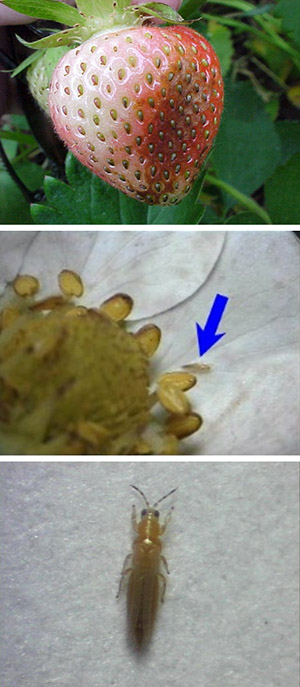
Eastern flower thrip damage
and insect. Photos: E. Wahle.
Peaches are moving from bloom into petal fall, with growers targeting brown rot and scab. Apples are moving into full bloom and growers have been in there apple scab program and moving into blossom blight. Grapes are at first leaf separated from the shoot tip. If Phomopsis has been an issue, the 1-3" growth stage is a critical control point. See complete pest management recommendations in the 2018 Midwest Fruit Pest Management Guide.
Eastern flower thrips, Frankliniella tritici, make their presence known in strawberry patches annually in Illinois. Damaged fruit is typically tan, brown or yellow-brown in color, hence the term "bronzing." The disorder occurs annually to some extent, but timing of its occurrence and severity varies from year to year. Bronzing of strawberry fruit often occurs in late spring and summer in Illinois. In some years, bronzing can result in a total loss due to unmarketable or undesirable fruit.
The eastern flower thrip is a tiny, slender, cigar shaped insect. Nymphs and adults have the same general shape. Nymphs are wingless, whitish yellow when small, and yellow when fully grown. Adults are yellowish brown, 1/16 inch long, and have narrow wings that are fringed with hairs. While resting, the wings are folded lengthwise over the back.
Adults are attracted to flowers of many different plants, including many plants in the Rosaceae family. Adults and nymphs feed using rasping-sucking mouthparts to obtain sap. On strawberry fruit, they begin feeding on seeds soon after the buds open. They feed on the tissue between the seeds as the fruit expands. Bronzing results from surface cells being killed. Eastern flowers thrips are not thought to overwinter in Illinois, but populations are thought to develop every year throughout the state as a result of long-distant migrations from southern states on high-level winds associated with weather fronts.
There are two active nymph stages and two inactive pupal-like nymph stages. The life cycle can be completed in several weeks, resulting in several generations per year. Because eastern flower thrips are very small, they are difficult to view with the naked eye. To aid in their detection, tap flowers onto a white or very dark plate, and look for the slender yellow thrips. Thrips are also visible within the strawberry flower structure with the aid of a 10x magnifying lens.
Thrips immigration is not a one-time event, so control has to be maintained throughout the critical bloom period of strawberries. Although thresholds have not been determined for the Midwest, data from outside growing areas suggests that control is warranted if counts of thrips exceed 2 per blossom. Of the insecticides labeled for use in commercial strawberry production, Brigade (bifenthrin) should work very well, and it has a 0-day PHI (no waiting period required between application and harvest). Among other effective insecticides, Danitol (fenpropathrin) has a 2-day harvest restriction. For a complete listing of control options, see the 2018 Midwest Fruit Pest Management Guide. Once harvest is already under way, control is recommended for unaffected fruit less than dime in diameter when thrips are detected at or above the threshold level.
Elizabeth Wahle (618-344-4230; wahle@illinois.edu)
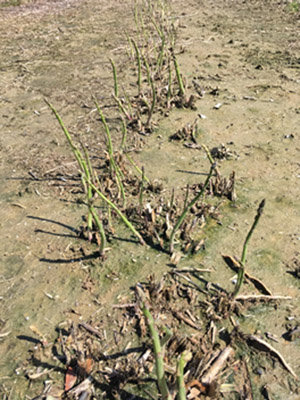
Asparagus growth in Murphysboro.
Photo by N. Johanning.
From southern Illinois... We have finally been feeling more spring-like with the last few days up in the 80s for highs and lots of sunshine. Even this past weekend we still had some morning lows down in the upper 30s, but no widespread frost to cause damage. We have been in a nice, fairly dry spell which has allowed growers to get out in the field. Many laying plastic mulch, planting, etc. Today (5/3) we did have some rain come through and have some rain chances which will slow things a little, but this has been the one of the best stretches of warm dry weather we have had for getting field work done.
Out in the field asparagus harvest is well under way. Our first harvest on our variety trial was on April 20, notably 20 days later than our first harvest in 2017 which was April 1. Since then, with the warmer weather harvests have really increased especially this week. Apples are in full bloom, most peaches have dropped their flower petals, and early blueberries are in bloom. The potatoes are starting to emerge on the potato trials we planted back on April 12 and the warm weather should push the remaining sprouts to emerge. In my experiences potatoes always seem to emerge across a week to 10 day window of time depending on how active the eye(s) are on that specific seed piece. "Pre-Sprouting" seed pieces by storing tuber in the light and warm (60-70°) ahead of planting can really help to get more of the eyes to break dormancy and speed up emergence. The more actively growing they are the faster they emerge, thus decreasing the chances of the seed piece from rotting before emergence, especially on cold wet years.
Hopefully the weather will continue to give us some warm, dry breaks to continue on with more field work!
Nathan Johanning (618-939-3434; njohann@illinois.edu)
From Dixon Springs Ag Center...Transplants in our cucumber variety trial were set out in perlite filled dutch buckets last Monday (April 23rd) and indeterminate tomato transplants were set out last Friday (April 27th). Both of these trials are being grown in our designated hydroponic tunnel. We plan to put in a single rep, observation trial of both the cucumber and indeterminate tomato varieties in a second tunnel in ground beds. These beds will have been amended with composted horse manure and steamed prior to transplanting. Other hydroponic demonstration systems are being set up this week, including a lettuce/greens table, strawberries in vertical stacks, and tomatoes in different grow bags. Once ground bed preparation is complete in the second high tunnel, a lot of transplants hanging out in the greenhouse will be happy to relocate to their new home.
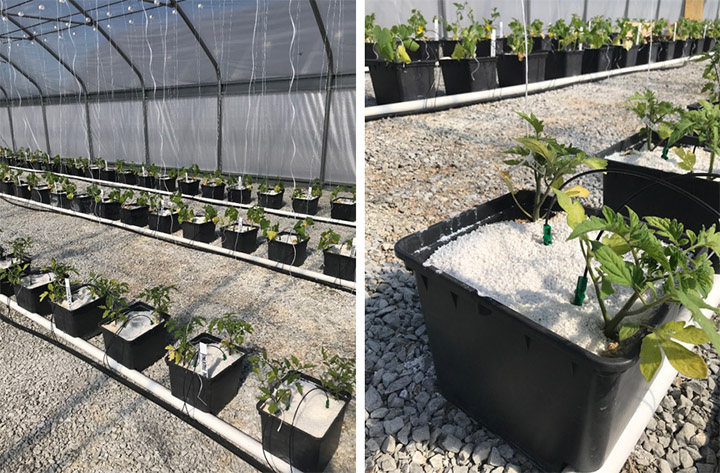
Hydroponic cucumber and indeterminate tomato variety trials established the week of April 23, 2018 at DSAC. Trellising was set up on April 30, 2018, with blooms noted on both crops. Remember to currently direct irrigation stakes to spray water towards the plants. Photos by B. Aly.
Bronwyn Aly (618-382-2662; baly@illinois.edu)
Fruit and Vegetable Production and Pest Management
Rednecked Cane Borer and other Cane and Crown Borers in Brambles
A slight revision of a newsletter article from May of 2016... Rednecked cane borer is a beetle; the adult stage is known as a metallic wood boring beetle, and larvae are called flat-headed wood borers. It has a 1-year life cycle. Beetles feed on leaf margins from May through August and lay eggs in bark of new growth, usually within 10 inches of the base of canes. Larvae tunnel through canes and reach full size by fall. They pupate in the spring, and adults emerge in May. Damage to canes is characterized by tunnels that spiral around the cane and by symmetrical swellings or galls 1-4 feet above the soil line. Pruning out and destroying galled canes in early spring is recommended for rednecked cane borer control. If more than 5% of canes are galled, a postbloom drench application of Admire Pro to soil for systemic uptake and control may be warranted. Do not apply Admire Pro prebloom or during bloom. Brigade applied to the base of canes when adults are active will give some adult control ... to avoid bee kill, do not apply when plants are in bloom and bees are foraging.
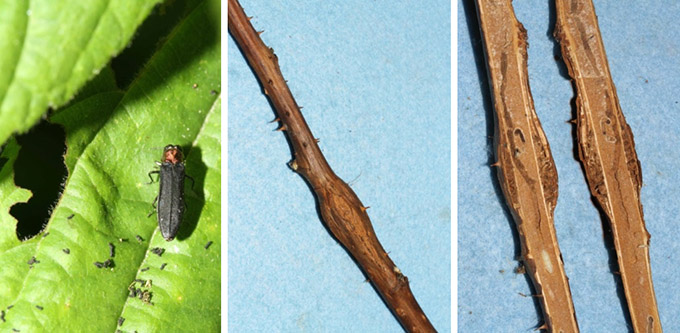
Left: Rednecked cane borer adult and feeding damage on foliage. Center: Gall caused by rednecked cane borer larva. Right: Tunneling inside cane by rednecked cane borer larva. (Photos by Phil Nixon)
A somewhat similar insect, raspberry cane borer, is a longhorned beetle; the larval stage is known as a round-headed wood borer. Raspberry cane borer has a 2-year life cycle. Beetles feed on canes from June through August, and they lay eggs between rings of punctures on canes. Larvae tunnel to the base of canes by fall. They feed in crowns during their second summer, then pupate the following spring; adults emerge from June through August. To control raspberry cane borer, prune out and destroy infested canes, beginning in July. Foliar sprays of insecticides labeled against other bramble pests (including Brigade and Sevin) give some control of adults from late May until mid-July, but applications must be timed to avoid bee kill.

Raspberry cane borer adult, girdling and egg-laying puncture, wilted cane, and larva. (Photos from NRAES-35, Bramble Production Guide)
A third borer in brambles is the raspberry crown borer. It is a clear-winged moth, and its larval stage is a caterpillar with fleshy abdominal prolegs that bear hook-like "crochets." It also has a 2-year life cycle. Moths fly from August through September and lay their eggs on the undersides of leaves; eggs hatch in September and October and move down the canes to the crown. In their first fall, larvae form a hibernaculum below the soil line; they girdle canes and crowns the next summer before wintering in roots. They finish development and pupate in the second summer. To control this insect, apply a drench of Altacor, Brigade, or Hero to the crowns in a minimum of 50 gallons of water per acre after egg hatch in October or November or in late March. Time the application to precede irrigation or a significant rainfall. Biological control by drench application of insect-pathogenic nematodes (Steinernema feltiae) also is possible. Removing infested crowns is also recommended.
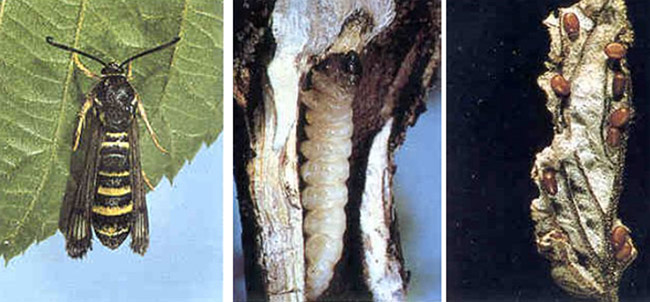
Raspberry crown borer adult, larva, and eggs. (Photos from NRAES-35, Bramble Production Guide)
For more information on these insects and listings of insecticides registered to control them, check the 2018 Midwest Fruit Pest Management Guide.
Eastern Flower Thrips on Strawberries
This week's strong southern winds are providing the first chance for some late-spring insects that migrate into the Midwest every year. They may start showing up as early as now, or they may not arrive in large numbers until a few weeks from now, but one that I will be scouting for in strawberries is eastern flower thrips. As strawberries bloom and berries begin to enlarge, they are vulnerable to damage from feeding by these insects. The eastern flower thrips is a tiny, yellow to brown insect less than 1/16 inch long. Adults are attracted to flowers of many different plants; their rasping feeding causes premature wilting of flower parts and blossom drop, as well as fruit deformities in some crops. Although this insect does not overwinter outdoors in Illinois, survival in greenhouses is presumed to occur, and populations develop each year throughout the state as a result of long-distance migrations from southern states on high-level winds associated with weather fronts. Immigration of thrips may occur simultaneously with immigration of the potato leafhopper.
To determine whether or not thrips control is warranted, strawberry growers should begin sampling for thrips by examining early flower clusters on early varieties and continue sampling all varieties as they begin to bloom. Tap flowers onto a white or very dark plate or saucer, and look for the slender yellow thrips. Alternatively, flower blossoms can be placed into a zip lock bag and shaken to dislodge thrips and allow counting. Although the relationship between thrips density and damage appears to be influenced by variety and weather conditions, control is probably warranted if populations exceed 2-10 thrips per blossom. This is a broad range of densities, but more a more precise threshold has not been established. If insecticides are to be used for thrips control, make applications before bloom is well underway (by the time 10 percent of the plants have open blossoms) to avoid killing pollinators. Entrust (1) and Radiant (1) are labeled for thrips control in strawberries. Lorsban (21), Danitol (2), and Brigade (0) are not labeled specifically for thrips control in strawberries but have been effective in field use at rates listed for clipper or spittlebug and tarnished plant bug; numbers in parentheses indicate the minimum preharvest interval (PHI) that must elapse between the last application of each insecticide and the harvest of fruit. For more details, see the 2018 Midwest Fruit Pest Management Guide.
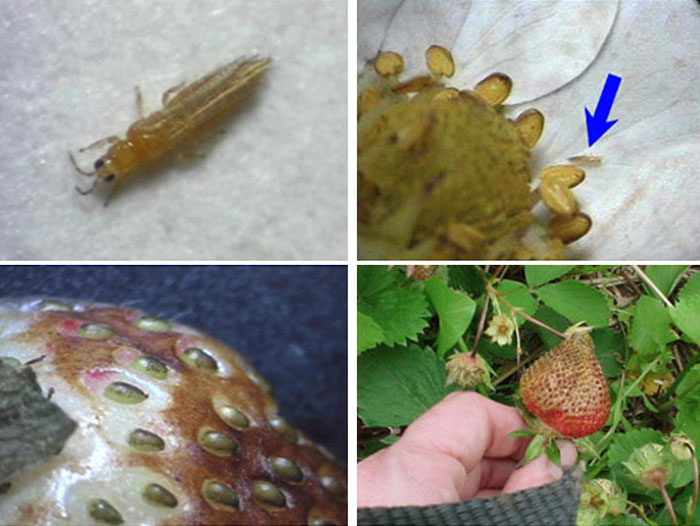
Top left: Adult eastern flower thrips; top right: thrips (at arrow) in strawberry blossom; bottom left: close-up of berry discoloration; bottom right: partially browned berry, likely caused by earlier feeding by eastern flower thrips. (Photos by Elizabeth Wahle)
Potato Leafhopper on Apples

Left to right: cupping of apple leaves as a result of potato leafhopper feeding, potato leafhopper nymph, and adult.
Southerly wind flows in late spring also carry potato leafhoppers into the Midwest from southern states. We usually anticipate the influx to be greatest in late May, but by now it's time to begin scouting for them. Potato leafhoppers feed on a wide range of fruit, vegetable, field crop, and landscape plants by inserting their needle-like mouthparts (stylets) into leaves and shoots, then sucking out plant fluids. In the process, they inject a salivary toxin into the leaves or shoots, causing a variety of symptoms, all of which are referred to as hopper burn. In apples, potato leafhopper feeding causes cupping of new leaves and greatly reduced growth of new shoots. In most years, potato leafhopper damage is most common in young trees that are not yet bearing fruit, as growers are not spraying them regularly for other insect pests (and coincidentally killing potato leafhopper). In addition, the switch from organophosphates such as Imidan and Guthion to alternatives such as Altacor, Rimon, and Delegate for codling moth control in apples allows potato leafhopper infestations to develop in fruit-bearing blocks, because these insecticides do not control potato leafhoppers.
Sample for potato leafhoppers by examining the undersides of leaves. Look for light-green, narrow, small (< 1/8 inch long) insects that tend to move sideways (instead of forward or backward) when disturbed. Thresholds suggested for potato leafhopper control range from treating whenever adults and nymphs are found on young trees to 1 adult or nymph per leaf on older trees where vigorous new growth is less important. Unlike white apple leafhopper (which is resistant to several insecticides), potato leafhopper is susceptible to most of the broad-spectrum insecticides used in apples – Imidan, neonicotinoids such as Assail and Calypso, pyrethroids such as Danitol (and others), and carbamates such as Lannate and Sevin. Again, Altacor, Delegate, and Rimon do not control potato leafhopper.
Potato Leafhopper on Green Beans and Potatoes

Potato leafhoppers and injury to potato and green bean leaves. (Photos, L to R, are from Michigan State University, Penn State University, and the University of Massachusetts.)
The same insect discussed above also damages certain vegetable crops. In Illinois vegetables, potato leafhopper is particularly damaging to potatoes and green beans. As it feeds by inserting its stylet into leaves and sucking out plant fluids, it also injects its saliva into the plant. The saliva is toxic to plants, and leaves typically yellow and curl and plant growth is stunted. See the 2018 Midwest Vegetable Production Guide for listings of registered insecticides.
Organic Control of Striped Cucumber Beetle
The April 26 issue of Purdue University's Vegetable Crops Hotline (newsletter) includes an article by Rick Foster and Laura Ingwell on organic control of striped cucumber beetles. It also includes a link to work on traps done by Dr. Jaime Pinero from Lincoln University in Missouri. The Hotline article is at https://vegcropshotline.org/article/organic-control-methods-for-striped-cucumber-beetles/.
Contributions from Weinzierl Fruit and Consulting, LLC are provided through support by the Illinois Specialty Growers Association. Visit www.specialtygrowers.org for more information or to join the association.
Rick Weinzierl, Weinzierl Fruit and Consulting, LLC (217-621-4957; raweinzierl@gmail.com)
Modified Growing Degree Days (Base 50°F, January 1 through April 30)
Station Location |
Actual Total |
Historical Average (11 year) |
One- Week Projection |
Two-Week Projection |
|---|---|---|---|---|
Freeport |
81 |
154 |
140 |
208 |
St. Charles |
100 |
153 |
155 |
219 |
DeKalb |
86 |
174 |
149 |
222 |
Monmouth |
138 |
215 |
205 |
285 |
Peoria |
151 |
242 |
223 |
308 |
Champaign |
160 |
244 |
233 |
320 |
Springfield |
219 |
279 |
298 |
393 |
Perry |
245 |
284 |
316 |
404 |
Brownstown |
231 |
338 |
315 |
414 |
Belleville |
276 |
369 |
362 |
465 |
Rend Lake |
301 |
403 |
394 |
505 |
Carbondale |
296 |
395 |
384 |
485 |
Dixon Springs |
376 |
440 |
470 |
578 |
Insect development is temperature dependent. We can use degree days to help predict insect emergence and activity. Degree day accumulations calculated using the Illinois IPM Degree-Day Calculator
Kelly Estes, State Survey Coordinator, Illinois Cooperative Agricultural Pest Survey (217-333-1005; kcook8@illinois.edu)
Brown Marmorated Stink Bug Update
The brown marmorated stink bug (BMSB) is old news for many Illinois residents by now. While it is quickly becoming the time of year where these insects are found outdoors, we receive many reports over the winter months when they overwinter in homes.
Discovered in Illinois in 2010, BMSB has now been confirmed in 49 counties (Figure 1). We suspect it is much wider spread than this, but have not had samples or photos submitted from unconfirmed counties. We encourage the reporting of this insect in unconfirmed counties. As numbers increase throughout the state, we also expect to see injury to host plants commonly found in gardens, orchards, and field crops.
As a quick refresher, BMSB is distinct in appearance from other common stink bugs in Illinois (figure 3). As we move into the growing season, keep your eyes peeled for this insect as they transition from their overwintering locations to host plants outdoors. Injury may occur as early as late May in areas near high populations, but the majority of damage will occur with the onset of the adults of the summer generation. A great refresher on at-risk crops along with descriptions of BMSB damage can be found at www.stopbmsb.org.
We receive numerous reports of BMSB as nuisance pests, this year we would really like to have any reports of crop damage reported as we continue to update our status maps ((figure 2). Please report any injury to your local extension educator or myself.
anyone looking for see pest updates, learn more about invasive species, or find out what's going on in between issues of the Illinois Fruit and Vegetable News, you can find the IL Pest Survey on Facebook (https://www.facebook.com/ILPestSurvey/), Twitter (https://twitter.com/ILPestSurvey), and Instagram (https://www.instagram.com/ilpestsurvey/). As we progress through the growing season, posts will become more diversified in invasive species, garden pests, crop pests, and more.
Table 1. Estimated dates when brown marmorated stink bug (BMSB) life stages are expected to appear during the season. The model is based on using a 13.5-hour day as the biofix for BMSB emerging from overwintering, 135 degree-days (DD base 57.2F) until egg laying begins and 1103 accumulated degree-days for those eggs to develop to adults. | ||||
|---|---|---|---|---|
|
1st overwinter adult expected |
Egg Laying Begins |
Various nymph stages present from end of May through mid-August |
New (summer generation adults expected |
Environmental Cue |
13.5 hr day |
135 DD (base 57.2F) |
1103 DD (base 57.2F) |
|
Northern IL |
April 18 |
May 25 |
July 29 |
|
Central IL |
April 21 |
May 22 |
July 18 |
|
Southern IL |
April 24 |
May 13 |
July 11 |
|
Kelly Estes, State Survey Coordinator, Illinois Cooperative Agricultural Pest Survey (217-333-1005; kcook8@illinois.edu)
Pruning Determinate Tomatoes
I have recently received a number of calls from growers about how to prune determinate tomatoes in a stake and weave system. Although this is relatively easy compared to how to prune indeterminate tomatoes with a trellis system, there are a few things I would like to call to your attention.
What to prune
The common practice is to prune the suckers at the bottom of tomato plants. The benefit of this practice is to improve airflow which may help to control foliar diseases. Shoots of determinate tomatoes stop growing once they set a terminal bud. Most of us understand that if suckers are pruned too much, plants may have reduced yield. However, there is confusion about exactly what to prune.
Normally, the bottom 6-7 suckers should be pruned until the first flower cluster. But it is important to note that the sucker just below the first flower cluster develops a very strong shoot (Figure 1), which will produce a large number of tomatoes. We find it works best to leave this sucker and prune everything below this point (Figure 2).
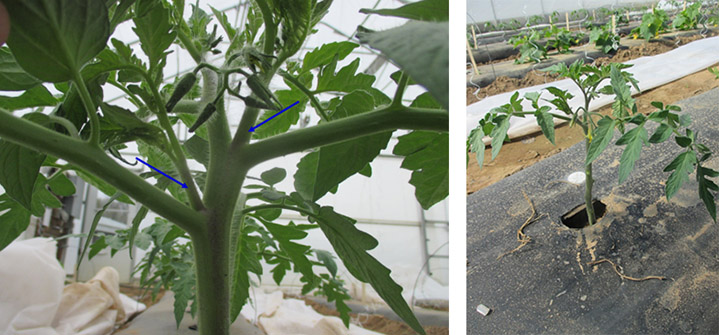
Figure 1 (above & left). Leave the sucker right below the first flower cluster (indicated by the arrow on the right), prune the sucker indicated by the arrow on the left, and all the suckers below it.
Figure 2 (right). A tomato plant that has been pruned. Sometimes it works better to prune suckers first and prune bottom leaves when they begin to decline.
Photos: W. Guan.
When to prune
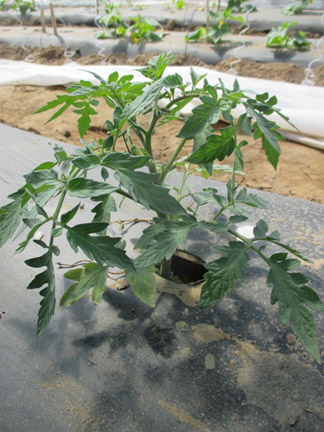
Figure 3. Prune the suckers when the first flower
cluster starts to bloom. Photo W. Guan.
The ideal time to prune suckers is about when the first flower cluster start to bloom, around the stage showing in Figure 3. If suckers are pruned before the formation of the first flower cluster, it is difficult to know exactly what to prune. While if plants are pruned too late until the suckers grow big, removing suckers will create large lesions on the stem that facilitate the infection of pathogens. Another important consideration is that it is best for the lesions to dry out as soon as possible so there is less chance of disease infection. With this in mind, the morning of a sunny day normally is the best time to prune the plants.
Wenjing Guan, Clinical/Engagement Assistant Professor, Southwest Purdue Agricultural Center, Purdue University (812-886-0198; guan40@purdue.edu)
Less Seriously...
Who doesn't love Star Wars Day? With the late spring frosts and the wide range of precipitation levels in 2018, let us just say...May the 4th be with you!

https://heavy.com/social/2015/05/may-the-fourth-4th-be-with-you-memes-gifs-jokes-quotes/18/

http://www.geekadelphia.com/2016/05/02/this-wednesday-may-the-4th-be-with-you-all-over-philadelphia/
University of Illinois Extension Specialists in Fruit and Vegetable Production & Pest Management
Extension Educators – Local Food Systems and Small Farms |
||
Bronwyn Aly, Gallatin, Hamilton, Hardin, Pope, Saline, and White counties |
618-382-2662 |
|
Katie Bell, Franklin, Jackson, Perry, Randolph, & Williamson counties |
618-687-1727 |
|
Sarah Farley, Lake & McHenry counties |
847-223-8627 |
|
Nick Frillman, Woodford, Livingston, & McLean counties |
309-663-8306 |
|
Laurie George, Bond, Clinton, Jefferson, Marion, & Washington counties |
618-548-1446 |
|
Zachary Grant, Cook County | 708-679-6889 | |
Doug Gucker, DeWitt, Macon, and Piatt counties |
217-877-6042 |
|
Erin Harper, Champaign, Ford, Iroquois, and Vermillion counties |
217-333-7672 |
|
Grace Margherio, Jackie Joyner-Kersee Center, St. Clair County |
217-244-3547 |
|
Grant McCarty, Jo Daviess, Stephenson, and Winnebago counties |
815-235-4125 |
|
Katie Parker, Adams, Brown, Hancock, Pike and Schuyler counties |
217-223-8380 |
|
Kathryn Pereira, Cook County |
773-233-2900 |
|
James Theuri, Grundy, Kankakee, and Will counties |
815-933-8337 |
|
Extension Educators – Horticulture |
||
Chris Enroth, Henderson, Knox, McDonough, and Warren counties |
309-837-3939 |
|
Richard Hentschel, DuPage, Kane, and Kendall counties |
630-584-6166 |
|
Andrew Holsinger, Christian, Jersey, Macoupin, & Montgomery counties |
217-532-3941 |
|
Extension Educators - Commercial Agriculture |
||
Elizabeth Wahle, Fruit & Vegetable Production |
618-344-4230 |
|
Nathan Johanning, Madison, Monroe & St. Clair counties |
618-939-3434 |
|
Campus-based Extension Specialists |
||
Kacie Athey, Entomology |
217-244-9916 |
|
Mohammad Babadoost, Plant Pathology |
217-333-1523 |
|